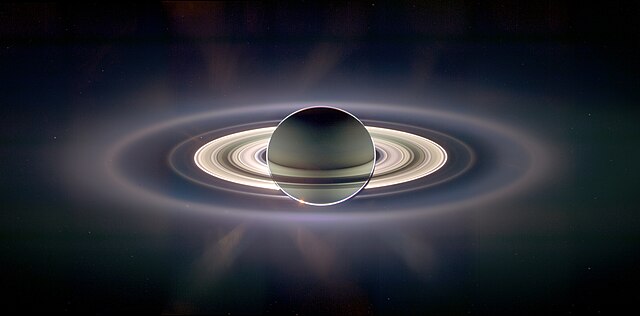بی شک زحل بهدلیل حلقههایش زیباترین جسمی است که در منظومه شمسی میتوان با یک تلسکوپ کوچک دید. کلید سردرگمی گالیله در توضیح هویگنس نهفته است؛ سیستم حلقوی، بهدلیل کجی محور زحل، نسبت به دایرةالبروج مایل است. تصور کنید که قطب شمال زحل در نقطهای از مدارش به سمت خورشید کج شده باشد. ما، روی زمین نزدیک به خورشید، بیشتر نیمکرۀ شمالی و حلقهها را در بازترین حالت خود خواهیم دید. درست کمتر از 15 سال بعد زحل در نقطۀ مقابل مدار خود قرار دارد، در حالیکه حالا قطب جنوب آن به سمت خورشید کج شده است. بدین ترتیب نیمکرۀ جنوبی را بهتر میبینیم و حلقهها نیز کاملاً گسترده هستند. در بین راه، وسط این دو حد، حلقهها را در حالی که لبۀ آنها به سمت ما است میبینیم و درست همانگونه که گالیله مشاهده کرد، به نظر میرسد که حلقهها ناپدید شدهاند. بنابراین زمین، در هر دور گردش زحل، دوبار در صفحۀ حلقههای آن قرار میگیرد؛ تقریباً هر 15 سال یکبار.

تصویری از زحل که بهوسیلۀ فضاپیمای کاسینی و در هنگام گرفت خورشید توسط زحل عکسبرداری شده است. سمت دور زحل از خورشید تاحدی بهوسیلۀ نور بازتابی از حلقهها روشن شده است.
تعجبی نیست که حلقهها ظاهراً ناپدید بشوند زیرا تصور بر این است که ضخامت آنها کمتر از یک کیلومتر است. اندازۀ ذرات تشکیل دهندۀ حلقهها متفاوت است؛ از غبار گرفته تا قطعاتی به قطر چند متر که عمدتاً از یخِ آب (حدود 93%) همراه با کربن غیر بلوری (حدود 7%) درست شدهاند. از زمین سه حلقه قابل مشاهده است که از ارتفاع ۶۶۳۰ کیلومتر تا ۱۲۰۰۰۰ کیلومتر بالای استوای زحل کشیده شدهاند. حلقۀ بیرونی، حلقۀ A، شکافی برجسته بهنام شکاف انکه (Enke Division) دارد؛ درحالیکه شکاف کاسینی حلقۀ A را از حلقۀ میانی B، یا حلقۀ روشن، جدا میکند. دو حلقه دیگر نیز اخیراً کشف شده است؛ درون حلقۀ C یک حلقۀ کمنور D بهچشم میخورد و در حلقۀ بیرونی A یک حلقۀ نازک F.
کتاب "درآمدی بر نجوم و کیهان شناسی" صفحه ۱۴۶ و ۱۴۷.
There is no doubt that, due to its ring system, Saturn is the most beautiful object
in the Solar System that can be observed with a small telescope. The
key to understanding Galileo’s confusion lies in Huygens’s description that the ring
system was inclined to the ecliptic due to Saturn’s axial tilt. Assume that Saturn’s
North Pole was, at some point in its orbit, tilted closest to the Sun. Close to the
Sun we, on Earth, would see much of the northern hemisphere and the rings at
their most open. Just under 15 years later, Saturn will be on the opposite side of
its orbit and the North Pole would be tilted away from the Sun. We would then see
the southern hemisphere best and the rings would also be wide open. Half way in
between these extremes we see the rings edge-on and, just as Galileo observed, they
effectively disappear. Hence, the Earth will lay in the ring plane twice every orbit,
about once every15 years.
It is not surprising that the rings effectively disappear as it is thought that they
are less than 1 km in thickness! The ring particles range in size from dust par-
ticles up to boulders a few metres in size and are largely composed of water ice
(∼93%) along with amorphous carbon (∼7%). Three rings can be observed from
Earth that extend from 6630 to 120 700 km above Saturn’s equator. The outer
ring, A ring, has a signifi cant gap within it, called Enkes Division, whilst Cassini’s
Division separates the A from the middle B, or Bright Ring. Two further rings have
been discovered more recently; within the C ring there is a very faint D ring, whilst
outside the A ring is a very thin F ring.
"Introduction to Astronomy and Cosmology" Page 114


 بنام آفریدگار بی همتا
بنام آفریدگار بی همتا